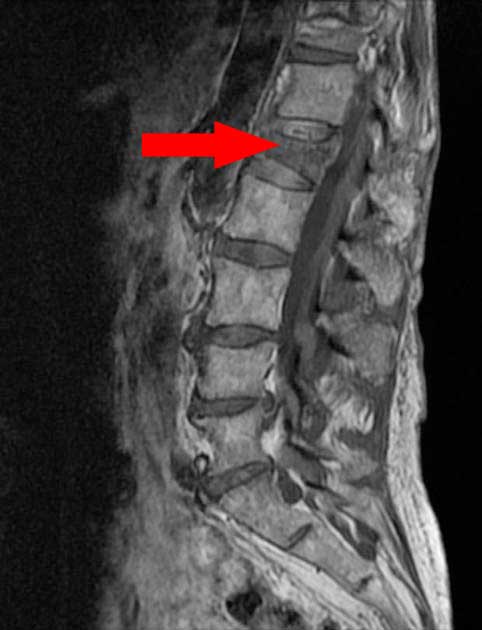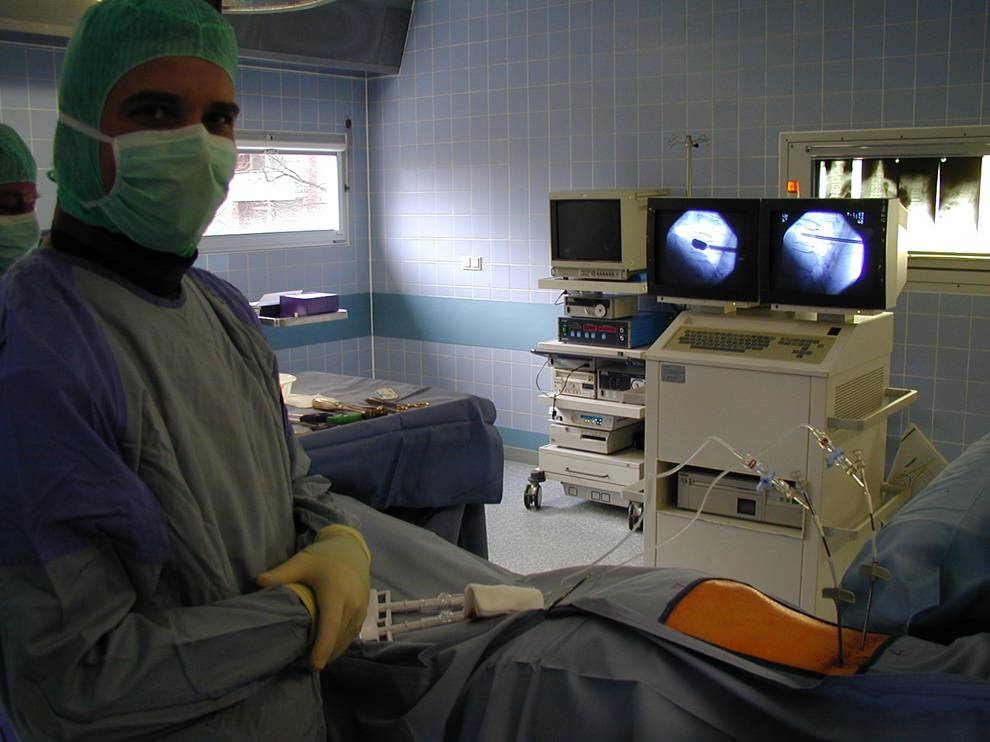Incidence and Prevalence
Vertebral compression fractures (VCFs) occur when the bony block or vertebral body in the spine collapses, which can lead to severe pain, deformity and loss of height. These fractures more commonly occur in the thoracic spine (the middle portion of the spine), especially in the lower part.
Causes
In people with severe osteoporosis (weak, brittle bones), a VCF may be caused by simple daily activities, such as stepping out of the shower, sneezing forcefully or lifting a light object. In people with moderate osteoporosis, it usually takes increased force or trauma, such as falling down or attempting to lift a heavy object to cause a VCF. VCFs are the most common fracture in patients with osteoporosis, affecting about 750,000 people annually. VCFs affect an estimated 25% of all postmenopausal women in the U.S. The occurrence of this condition steadily increases as people age, with an estimated 40% of women age 80 and older affected. Although far more common in women, VCFs are also a major health concern for older men.
People who have had one osteoporotic VCF are at five times the risk of sustaining a second VCF. Occasionally, a VCF can be present with either minor symptoms or no symptoms, but the risk still exists for additional VCFs to occur.
People with healthy spines most commonly suffer a VCF through severe trauma, such as a car accident, sports injury or a hard fall.
Metastatic tumors should be considered as the cause in patients younger than 55 with no history of trauma or only minimal trauma. The bones of the spine are a common place for many types of cancers to spread. The cancer may cause destruction of part of the vertebra, weakening the bone until it collapses.
Symptoms
The main clinical symptoms of VCFs may include any of the following, alone or in combination:
- Sudden onset of back pain
- An increase of pain intensity while standing or walking
- A decrease in pain intensity while lying on the back
- Limited spinal mobility
- Eventual height loss
- Eventual deformity and disability
When & How to Seek Medical Care
You should see a doctor to evaluate back pain if:
- You are older than 65 years old or younger than 12 years old
- Your pain is the same at rest as it is while active
- You have unintentional weight loss
- You have or have had cancer
You may first make an appointment with your primary care physician, or you can find a neurosurgeon using the Find a Board-certified Neurosurgeon tool on the AANS website.
Seek immediate medical attention at an emergency department if you have any of the following symptoms in addition to back pain:
- Loss of control of your bowels and bladder
- Severe pain, numbness, or weakness
- High fever
Testing & Diagnosis
While a diagnosis can usually be made through history and a physical examination, plain x-rays, computed tomography (CT) or magnetic resonance imaging (MRI) can help in confirming diagnosis, predicting prognosis and determining the best treatment option for the patient.
- X-ray: An x-ray produces a picture of a part of the body and can show the structure of the vertebrae and the outline of the joints. It will also show bone alignment, disc degeneration and bony spurs which may irritate nerve roots.
- CT or CAT scan: A diagnostic image created after a computer reads x-rays; can show the shape and size of the spinal canal, its contents and the structures around it. This test may be performed in conjunction with a myelogram of the spine to provide additional information. A myelogram involves a spinal tap where dye is administered near the spinal cord. This diagnostic study is ideal for showing bone detail including narrowing.
- MRI: A diagnostic test that produces 3-D images of body structures using powerful magnets and computer technology; can show the spinal cord, nerve roots and surrounding areas, as well as enlargement, degeneration and tumors.
- Dual-energy x-ray absorptiometry (DXA or DEXA) or bone densitometry: This test is the established standard for measuring bone mineral density and can determine if osteoporosis exists. The scanner painlessly and rapidly directs x-ray energy from two different sources towards the bone being examined in an alternating fashion at a set frequency. A DEXA scan can detect small changes in bone mass and is also more flexible since it can be used to examine both the spine and the extremities. A scan of the spine, hip or the entire body requires less than four minutes.
Treatment
Non-Surgical Treatments

Pain secondary to acute vertebral fracture appears to be caused in part by vertebral instability (nonunion or slow-forming union) at the fracture site. VCF-related pain that is allowed to heal naturally can last as long as three months. However, the pain usually decreases significantly in a matter of days or weeks. Traditionally, people with severe pain from VCFs have been treated with reduction in activities other than those which involve caring for yourself, medications, bracing or invasive spinal surgery, often with limited effectiveness. Extended inactivity should be avoided.
Over-the-counter pain medications are often effective in relieving pain. Both acetaminophen and nonsteroidal anti-inflammatory drugs (NSAIDs) are commonly recommended. Muscle relaxants and medicines for nerve/bone pain are often prescribed. Opioids should only be used for very short periods of time (1-2 weeks) for acute pain.
Back bracing can provide external support to limit the motion of fractured vertebrae, similar to the support a cast provides on a leg fracture. The rigid style of back brace limits spine-related motion greatly, which may help reduce pain.
While immediate treatment is essential to helping the pain and risks of the fracture, prevention of subsequent fractures is very important. Your physician may prescribe bone-strengthening drugs known as bisphosphonates (i.e.: Actonel, Boniva and Fosamax) to help stabilize or restore bone loss.
When conservative treatment options have proven ineffective, two minimally invasive procedures, called vertebroplasty and kyphoplasty, may be considered as treatment options. Recent advances in spinal procedures have reduced the need for invasive surgery in many cases.
Surgery
Vertebroplasty for the treatment of VCFs was introduced in the U.S. in the early 1990s. The procedure is usually done on an outpatient basis, although some patients stay in the hospital overnight. Vertebroplasty takes from one to two hours to perform, depending on the number of vertebrae being treated. The procedure may be performed with a local anesthetic and intravenous (IV) sedation or general anesthesia. Using x-ray guidance, a small needle containing specially formulated acrylic bone cement is injected into the collapsed vertebra. The cement hardens within minutes, strengthening and stabilizing the fractured vertebra. Most experts believe that pain relief is achieved through mechanical support and stability provided by the bone cement. Kyphoplasty is a modification of this technique where a balloon is used to help guide the cement and to increase the height of the collapsed bone. The spaces created by the balloons are then filled with the cement.

Patients with the following criteria may be considered candidates for vertebroplasty or kyphoplasty:
- Osteoporotic VCFs in any area of the spine that have been present for more than two weeks, causing moderate to severe pain and unresponsive to conservative therapy
- Painful metastases and multiple myelomas
- Painful vertebral hemangiomas (benign, malformed vascular tumors composed of newly formed blood vessels)
- Vertebral osteonecrosis (a condition resulting from poor blood supply to an area of bone, which causes bone death)
- Reinforcement of a pathologically weak vertebral body before a surgical stabilization procedure
Patients with any of the following criteria should not undergo these procedures:
- A VCF that is completely healed or is responding effectively to conservative therapy
- A VCF that has been present for more than one year
- Greater than 80-90% collapse of the vertebral body
- Spinal curvature, such as scoliosis or kyphosis, that is due to causes other than osteoporosis
- Spinal stenosis or herniated discs with nerve or spinal cord compression and loss of neurological function not associated with a VCF
- Untreated coagulopathy (a disease or condition affecting the blood’s ability to coagulate)
- Osteomyelitis (an inflammation of the bone and bone marrow, usually caused by bacterial infection)
- Discitis (nonbacterial inflammation of an intervertebral disc or disc space)
- Significant compromise of the spinal canal caused by impeding bone fragment or tumor
Complication rates for vertebroplasty and kyphoplasty have been estimated at less than 2% for osteoporotic VCFs and up to 10% for malignant tumor-related VCFs. The benefits of surgery should always be weighed carefully against its risks. Although a large percentage of patients report significant pain relief after these procedures, there is no guarantee that surgery will help every individual.
Follow-up
Follow all instructions given to you by your doctor, and ask questions if you are not sure what to do.
- Take any medications as prescribed.
- Applying ice to your area of pain may help. After one week after your pain starts, either ice or heat may be applied. Apply the one that makes your injury feel better.
- Do not do painful or strenuous activities or lift heavy objects until your doctor has cleared you to do so.
- Attend all follow-up appointments to ensure you are recovering well.
Resources for More Information
- Medline Plus. (2019) Compression fractures of the back.
- American Academy of Orthopedic Surgeons. OrthoInfo. (2019). Osteoporosis and Spinal Fractures.
Note from AANS
The AANS does not endorse any treatments, procedures, products or physicians referenced in these patient fact sheets. This information provided is an educational service and is not intended to serve as medical advice. Anyone seeking specific neurosurgical advice or assistance should consult his or her neurosurgeon, or locate one in your area through the AANS’ Find a Board-certified Neurosurgeon online tool.
